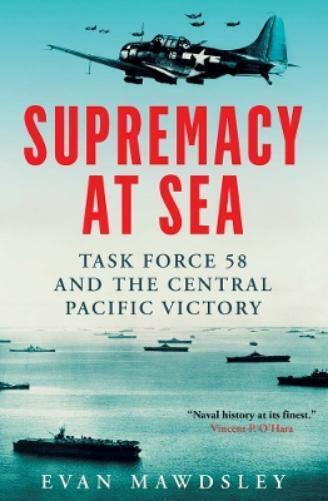
Supremacy at Sea. Task Force 58 and the Central Pacific Victory. By Evan Mawdsley. Yale University Press, Newhaven and London, 2024. ISBN 978-0-300-25545-4
Reviewed by David Hobbs
Evan Mawdsley is a naval historian and former professor of international history at the University of Glasgow. His previous book, The War for the Seas: A Maritime History of World War II, was awarded the Anderson Medal for the best maritime non-fiction book of 2019, an award made annually by the Society for Nautical Research in memory of Dr Roger Anderson a distinguished naval history scholar and a founder member of the Society.
It is awarded to the author of a book which, in the opinion of the judges, constitutes the outstanding contribution to maritime history in the previous twelve months.
In this later book Mawdsley describes the creation of the US Navy’s fast carrier task force, designated Task Force 58 during the period covered, and the key role it played in the USN’s successful Central Pacific operations between January and August 1944. Mawdsley writes with clarity and his text is supported by 62 well-chosen black and white photographs and 9 maps, many of which have enlarged inserts that enhance a particular element of a battle or task force movement.
The US Pacific Fleet had reached a low point in October 1942 after the Battle of Santa Cruz in which the carrier Hornet was overwhelmed by Japanese carrier-borne aircraft which carried out co-ordinated torpedo and dive-bomber attacks, leaving her on fire and abandoned to be sunk by Japanese destroyers. By 1944, however, new USN fast carriers, aircraft and the largest training scheme for naval pilots and aircraft technicians the world had ever known resulted in the creation of the fast carrier task force that swept the aircraft of the Imperial Japanese Navy from the central Pacific. The new force was not without its opponents, however, and some American admirals still regarded battleships as offering a more effective method of bringing the enemy fleet to action. Mawdsley describes the opinions put forward by the gun lobby, known colloquially as the ‘black shoe Navy’, and the naval aviators who wore brown shoes with their aviation green or khaki uniforms. Vice Admiral Raymond Spruance who commanded the 5th Fleet in the Central Pacific was one of the former and Vice Admiral Marc Mitscher who commanded the fast carrier task force was one of the latter; in fact one of the earliest US naval aviators. Their differing views on how to fight their way through the opposition to achieve their objectives make interesting reading.
The 1944 operations described constitute only part of a larger whole and this book must inevitably be compared with the complete picture described by Clark G Reynolds in The Fast Carriers – The Forging of an Air Navy, published by Mc Graw-Hill which I consider to be a better description of the Pacific Fleet’s carrier operations and the admirals who directed or led their activities. Reynolds’ book is long out of print, however, copies may not be easy to obtain and so I would, therefore, recommend Supremacy at Sea as a description of Task Force 58’s specific operations in 1944 up to the Battle of the Philippine Sea.
There are two things that I found disappointing, however. First is the omission of any mention of the period in late 1943 during which the British fleet carrier HMS Victorious was lent to the US Pacific Fleet. Her command team had considerable experience of air defence operations and USN fighter squadrons joined their RN equivalents embarked in her. Victorious’ torpedo-bomber squadron transferred to the USS Saratoga, the only operational USN carrier in the Pacific at the time, which had the better strike capability and both navies benefitted from this cross-fertilisation of methods and ideas.
The author’s extraordinary statement on page 236 that the Normandy landings in June 1944 ‘would be the last great effort of the Royal Navy’ was even more disappointing. His subsequent statement that ‘what it [the RN] could not do was extend successful naval operations to Southeast Asia and the Pacific’ shows a complete lack of understanding of the major achievements by both the East Indies Fleet and the British Pacific Fleet during 1945. The latter had been built up from late 1944 and in many ways matched the achievements of Task Force 58, operating alongside it within the 5th Fleet as Task Force 57. By August 1945 the BPF had grown rapidly into a force of 9 aircraft carriers, 4 battleships and over 50 cruisers and destroyers, the RN’s most powerful and effective fleet in the whole war. It was supported by a British fleet train including escort carriers operating in the escort, ferry and replenishment roles as well as stores ships, repair ships and tankers that enabled the BPF to operate continuously in the same manner as the Americans. This fleet and its logistic support including 7 new airfields in Australia and the Admiralty Islands were assembled rapidly despite the RN having already fought a gruelling war for five years. It had fewer ships but from January 1945 the BPF earned the USN’s respect in action, not least because of the ability of its carriers to continue flying operations after kamikaze hits and even a typhoon which damaged American carriers, some of them severely. This casual and unnecessary statement was outside the book’s central theme but certainly had an adverse effect on my overall impression of what was an otherwise good book.



